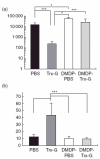Effects of alveolar macrophage depletion on liposomal vaccine protection against respiratory syncytial virus (RSV)
- PMID: 16792685
- PMCID: PMC1941998
- DOI: 10.1111/j.1365-2249.2006.03114.x
Effects of alveolar macrophage depletion on liposomal vaccine protection against respiratory syncytial virus (RSV)
Abstract
Little is known about the identities and roles of antigen-presenting cells upon exposure to antigens of respiratory syncytial virus (RSV). Here, we focused on elucidating the importance of alveolar macrophages in conferring protective immunity in mice administered a liposome-encapsulated recombinant fragment of the RSV G protein. Mice were depleted of alveolar macrophages by intranasal inoculation of liposome-encapsulated dichloromethylenediphosphonic acid (DMDP). Mice depleted of alveolar macrophages prior to immunization developed reduced levels of serum RSV-neutralizing antibody and showed dramatically impaired protection against RSV challenge. The severity of interstitial inflammation was also markedly reduced in macrophage-depleted mice. In conclusion, this study demonstrates a pivotal role for alveolar macrophages during exposure to liposome-encapsulated RSV antigen in initiating both protective and histopathological responses against RSV.
Figures





Similar articles
-
Innate and adaptive cellular phenotypes contributing to pulmonary disease in mice after respiratory syncytial virus immunization and infection.Virology. 2015 Nov;485:36-46. doi: 10.1016/j.virol.2015.07.001. Epub 2015 Jul 18. Virology. 2015. PMID: 26196232 Free PMC article.
-
Intranasal immunization with a replication-deficient adenoviral vector expressing the fusion glycoprotein of respiratory syncytial virus elicits protective immunity in BALB/c mice.Biochem Biophys Res Commun. 2009 Apr 17;381(4):528-32. doi: 10.1016/j.bbrc.2009.02.075. Epub 2009 Feb 20. Biochem Biophys Res Commun. 2009. PMID: 19233131
-
Enhanced immune responses and protection by vaccination with respiratory syncytial virus fusion protein formulated with CpG oligodeoxynucleotide and innate defense regulator peptide in polyphosphazene microparticles.Vaccine. 2012 Jul 27;30(35):5206-14. doi: 10.1016/j.vaccine.2012.06.011. Epub 2012 Jun 17. Vaccine. 2012. PMID: 22713718
-
Contribution of respiratory syncytial virus G antigenicity to vaccine-enhanced illness and the implications for severe disease during primary respiratory syncytial virus infection.Pediatr Infect Dis J. 2004 Jan;23(1 Suppl):S46-57. doi: 10.1097/01.inf.0000108192.94692.d2. Pediatr Infect Dis J. 2004. PMID: 14730270 Review.
-
Liposomes: a promising carrier for respiratory syncytial virus therapeutics.Expert Opin Drug Deliv. 2019 Sep;16(9):969-980. doi: 10.1080/17425247.2019.1652268. Epub 2019 Aug 7. Expert Opin Drug Deliv. 2019. PMID: 31382795 Review.
Cited by
-
Depletion of Alveolar Macrophages Does Not Prevent Hantavirus Disease Pathogenesis in Golden Syrian Hamsters.J Virol. 2016 Jun 24;90(14):6200-6215. doi: 10.1128/JVI.00304-16. Print 2016 Jul 15. J Virol. 2016. PMID: 27099308 Free PMC article.
-
Zbtb7a induction in alveolar macrophages is implicated in anti-HLA-mediated lung allograft rejection.Sci Transl Med. 2017 Jul 12;9(398):eaal1243. doi: 10.1126/scitranslmed.aal1243. Sci Transl Med. 2017. PMID: 28701473 Free PMC article.
-
Alveolar Macrophages in Viral Respiratory Infections: Sentinels and Saboteurs of Lung Defense.Int J Mol Sci. 2025 Jan 5;26(1):407. doi: 10.3390/ijms26010407. Int J Mol Sci. 2025. PMID: 39796262 Free PMC article. Review.
-
RSV Infection in Human Macrophages Promotes CXCL10/IP-10 Expression during Bacterial Co-Infection.Int J Mol Sci. 2017 Dec 7;18(12):2654. doi: 10.3390/ijms18122654. Int J Mol Sci. 2017. PMID: 29215596 Free PMC article.
-
Macrophages Orchestrate Airway Inflammation, Remodeling, and Resolution in Asthma.Int J Mol Sci. 2023 Jun 21;24(13):10451. doi: 10.3390/ijms241310451. Int J Mol Sci. 2023. PMID: 37445635 Free PMC article. Review.
References
Publication types
MeSH terms
Substances
LinkOut - more resources
Full Text Sources
Other Literature Sources
Medical

